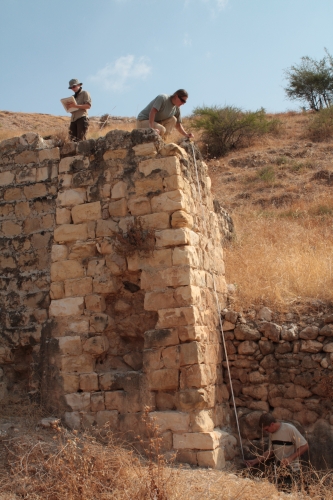Survey 2009 in the Wadi al'Arab
From 28th of July until 15th of August , 2009 a survey in the Wadi al'Arab and its vicinity was carried out. This survey is an integral part of the "Gadara Region Project". It is planned to be a hinterland survey for the Tall Zira'a excavation. The aim is to get a thorough understanding of the landscape in which the Tall Zira'a is the most prominent archaeological site. At the very heart of such an exploration there are questions of settlement pattern, distribution, relation and relative importance through time. Furthermore, the Wadi al'Arab is one of the easily passable ascents from the Jordan valley to the Irbid-Ramtha-basin and so has been part of trade routes from the Mediterranean coast to Damascus, Mesopotamia or Amman. Questions of the actual trade routes crossing this area and their changing importance arise. The survey is focused on evidence that could help answer these questions. It is evident that the information of the sites in the wadi and its vicinity has to be as detailed and up to date as possible.
The Wadi al'Arab has been surveyed several times before (Nelson Glueck 1942, Siegfried Mittmann 1963-66, and J.W. Hanbury-Tenison 1983). While all of them are valuable and gave wealthy sources of information, they cannot give the completeness and level of detail needed for the purpose of the "Gadara Region Project". The previus two surveys had a much broader area in view and therefore could only cover the major sites of our area of interest. J.W. Hanbury-Tenison's survey was limited to only two areas and does not cover the entire Wadi al'Arab. Furthermore, after almost a whole generation past, a new look on the existing data seems appropriate, especially with the much more elaborate stratigraphy and typology of the region that the continuing efforts of the "Gadara Region Project" are able to provide today.
With the knowledge of the previous surveys and the target of a hinterland survey in mind the approach chosen was two-fold: On the one hand revisiting the known sites enriching the information about them, on the other hand filling the gaps by surveying the areas that had not been surveyed before.This survey for landscpae archaeology is going to be carried out in three seasons of three weeks each. The survey season this year was the first within the scope of the "Gadara Region Project" after the reconnaissance by Dieter Vieweger in 1999.

One of the penstock mills
In this campaign 78 sites were recorded, 30 of them have not been published/known before. Over 80 % of the sites relate to the classical era. The other sites were inhabited in the Bronze Age, Iron Age or different Islamic periods. Lithic sites could not be discovered. The large Tall Kak and Tall Kinise were revisited. The area around the Wadi al'Arab Dam was covered as well which was partly surveyed by Kerestes in 1978 and Hanbury-Tenison in 1983. Furthermore, the slopes of the Wadi al'Arab from Tall Zira'a upwards to the region of Seidur and Doqara were surveyed. Most parts of this area had not been surveyed in detail before. While Seidur and Doqara are mentioned by Mittmann the surroundings revealed many sites which shed new light on the settlements' agricultural subsistence.
The northern slopes of the wadi directly upwards from Tall Zira'a are characterized by a dense occurence of water sources. Many of the sites found there relate to them. This can shed further light on the Roman water management in the region.
One smaller site directly across the wadi from the Tall Zira'a deserves special mentioning. This site was published first by Kerestes in 1978 (site 2 in the Wadi al'Arab) and identified to be of Middle Bronze Age date. Its position relates this site directly to Tall Zira'a. Together they control a narrow passage in the wadi and of course a direct line of sight is given between them. Just 50 m up the slope another previously unknown/unpublished site could be recorded with architectural remains of the Roman period. This site does not only overlook the lower wadi, as the nerby older one, it has also a direct line of sight to Gadara which is missing in the lower position. This gives us a hint on the shifting of central settlement from the Tall Zira'a to Gadara during the classical era.
In the Wadi al'Arab above the Tall Zira'a five penstock mills were recorded together with two dams. (Hanbury-Tenison only mentioned three mills.) All of them can be dated to the Ottoman period.
Outlook
In spring 2010, the next excavation campaign will be carried out to uncover the strata of the Late and Middle Bronze Ages in Area I on Tall Zira'a.
The survey in the Wadi al'Arab will be continued in summer 2010.
Problems
One important result of revisiting the previously published sites during the survey in the Wadi al'Arab is the observation of heavy destruction on many sites in the last decades. The rapid increase of deterioration is alarming. Only recently a large tall with Roman, Byzantine and Islamic occupation (no. 26 in the Hanbury-Tenison survey) has been completely destroyed by bulldozing. Several smaller sites are destroyed by agricultural activities, especially olive tree cultivation leaves sites in an unrecognizable state. These observations lead the members of the "Gadara Region Project" to the firm commitment to execute this survey not only as a necessary complement to an excavation but also as a preservation of knowledge on the history of the Wadi al'Arab, most of which will be lost in the near future.
|
Project Partners |
|
Biblical Archaeological Institute Wuppertal (BAI) |
|
Patronage |
|
His Royal Highness Prince El Hassan bin Talal took up the patronage of this project as a representative of the royal house. |
Friends and Donors |
|
Cooperations |
|
We cooperate closely with many universities, institutes and companies.  |

 print version
print version
